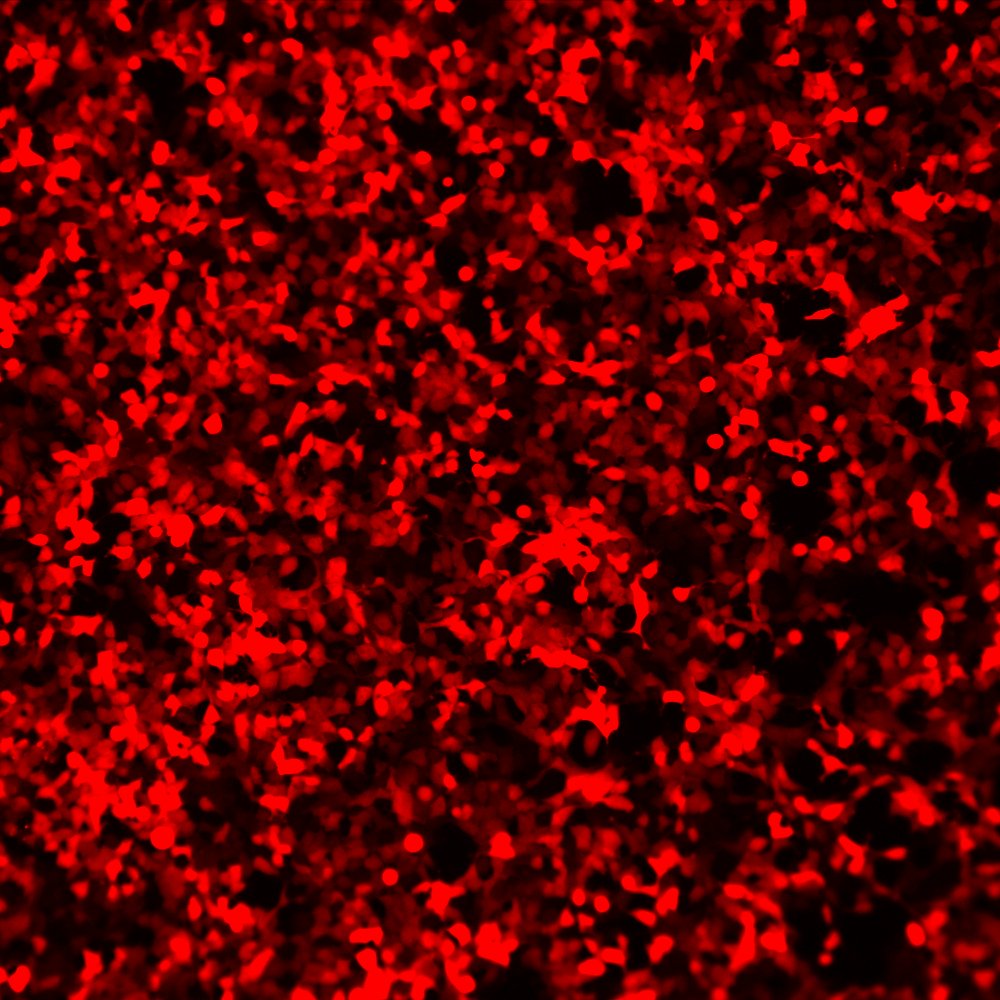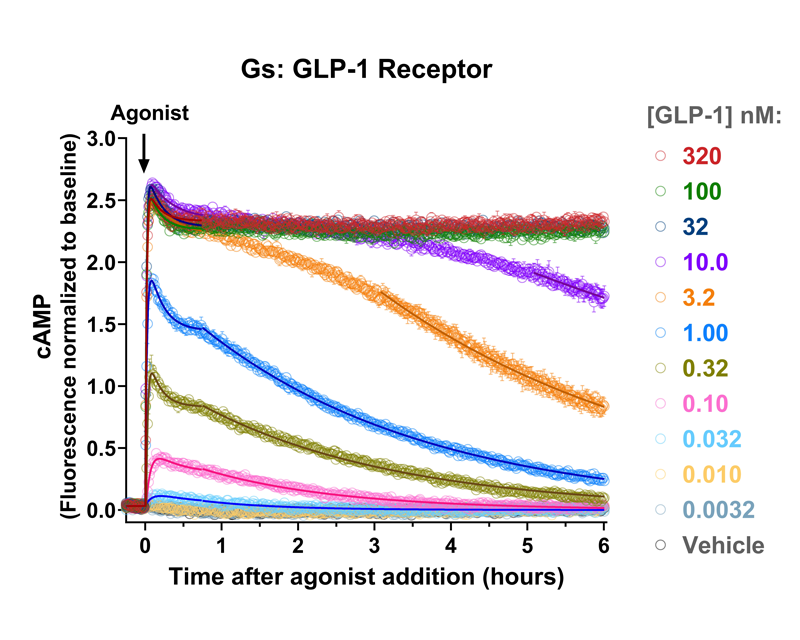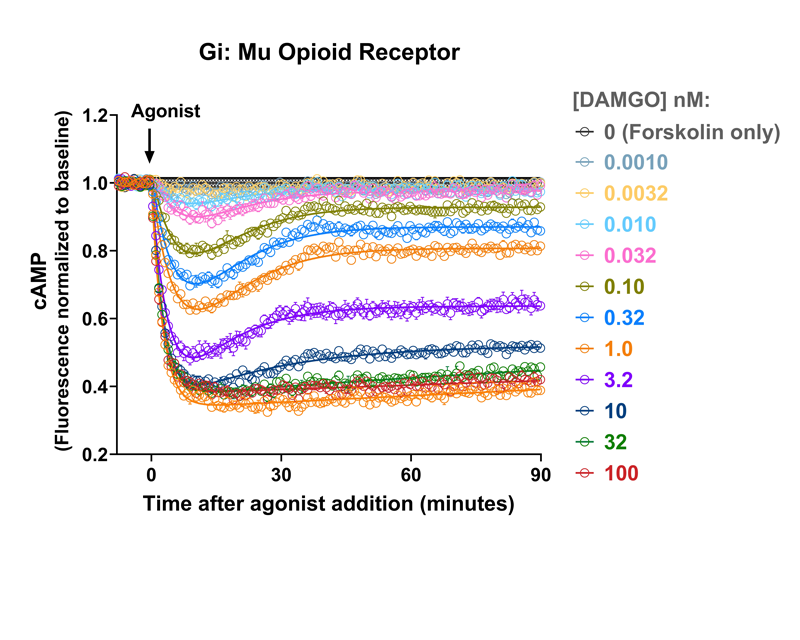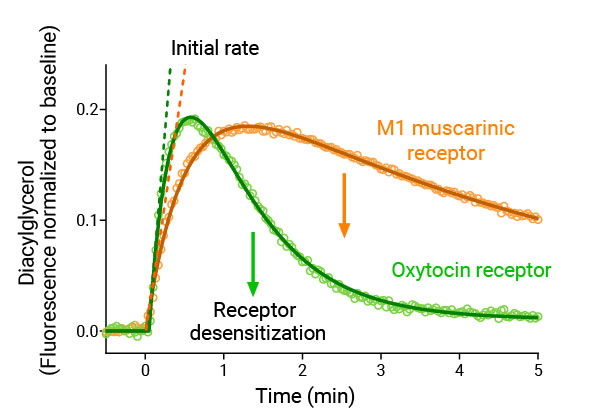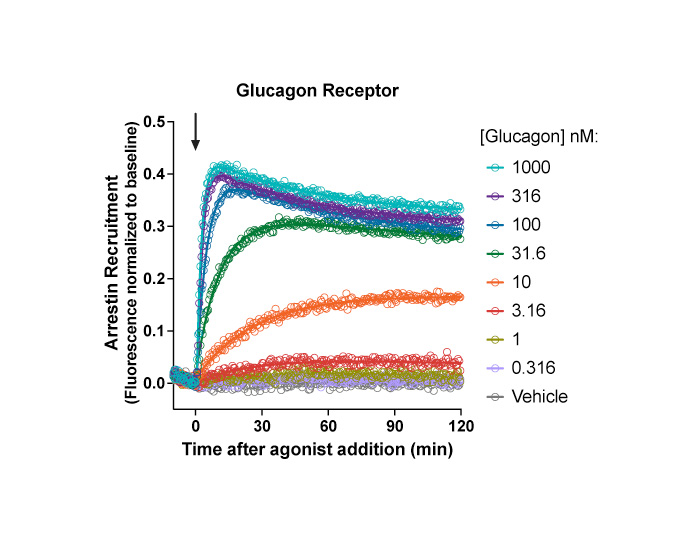
GPCRs in BacMam
Express GPCRs in mammalian cells
- Unmodified, untagged, human GPCRs
- Packaged in BacMam for consistent, titratable expression in most mammalian cell types – including cell lines, iPSCs, and primary cultures
- Easily co-express with biosensors for GPCR signaling
- Custom viruses, including splice or species variants, cell-specific promoters, genetic tags, and more are available on request
GPCR Catalog
Ready-to-ship kits
Full List
#Z0100N: Human D1 Dopamine Receptor (DRD1)
#Z0110N: Human D2 Dopamine Receptor (DRD2)
#Z0120N: Human D3 Dopamine Receptor (DRD3)
#Z0200N: Human M1 Muscarinic Receptor (CHRM1)
#Z0200G: Human M1 Muscarinic Receptor (CHRM1) – Green
#Z0200R: Human M1 Muscarinic Receptor (CHRM1) – Red
#Z0210N: Human M2 Muscarinic Receptor (CHRM2)
#Z0220N: Human M3 Muscarinic Receptor (CHRM3)
#Z0300N: Human A1 Adenosine Receptor (ADORA1)
#Z0400N: Human Succinate Receptor (SUCNR1)
#Z0500N: Human β2 Adrenergic Receptor (ADRB2)
#Z0500G: Human β2 Adrenergic Receptor (ADRB2) – Green
#Z0500R: Human β2 Adrenergic Receptor (ADRB2) – Red
#Z0600N: Human GLP-1 Receptor (GLP1R)
#Z0610N: Human Calcitonin Receptor (CALCR)
#Z0620N: Human Vasopressin Receptor (AVPR2)
#Z0700N:Human Nociceptin Opioid Receptor (OPRX)
#Z0710N: Human Kappa Opioid Receptor (OPRK1)
#Z0720N:Human Mu Opioid receptor (OPRM1)
#Z0730N: Human Cannabinoid Receptor Type 1 (CNR1)
#Z0740N: Human Delta Opioid Receptor (OPRD1)
#Z0800N: Human Angiotensin II Type I Receptor (AGTR1)
#Z0900N: Human Oxytocin Receptor (OXTR)
#Z1000N: Human C-X-C Chemokine Receptor Type 4 (CXCR4)
#Z1100N: Human Serotonin 5HT2A Receptor (HTR2A)
#Z1200N: Human Proteinase-Activated 2 Receptor (PAR2-F2RL1)
#Z1300N: Human Lysophosphatidic Acid 1 Receptor (LPAR1)
#Z1400N: Human Parathyroid Hormone 1 Receptor (PTH1R)
#Z1500N: Human Serotonin 5-HT1A Receptor (HTR1A)
#Z1600N: Human Gastric Inhibitory Polypeptide Receptor (GIPR)
#Z1700N: Human Cannabinoid Receptor Type 2 (CNR2)
#Z1800N: Human Serotonin 5HT2C Receptor (HTR2C)
#Z1900N: Human Serotonin 5-HT1B Receptor (HTR1B)
#Z2000N: Human Glucagon Receptor (GCGR)
#Z2100N: Human Somatostatin Receptor Type 2 (SSTR2)
Gs-coupled receptors
Gi-coupled receptors
- Human D2 Dopamine Receptor (DRD2)
- Human D3 Dopamine Receptor (DRD3)
- Human M2 Muscarinic Receptor (CHRM2)
- Human A1 Adenosine Receptor (ADORA1)
- Suman Succinate Receptor (SUCNR1)
- Human Kappa Opioid Receptor (OPRK1)
- Human Cannabinoid Receptor Type 1 (CNR1)
- Human Mu Opioid receptor (OPRM1)
- Human Nociceptin Opioid Receptor (OPRX)
- Human Delta Opioid Receptor (OPRD1)
- Human C-X-C Chemokine Receptor Type 4 (CXCR4)
- Human Lysophosphatidic Acid 1 Receptor (LPAR1)
- Human Serotonin 5-HT1A Receptor (HTR1A)
- Human Cannabinoid Receptor Type 2 (CNR2)
- Human Serotonin 5-HT1B Receptor (HTR1B)
- Human Somatostatin Receptor Type 2 (SSTR2)
Gq-coupled receptors
- Human Calcitonin Receptor (CALCR)
- Human Oxytocin Receptor (OXTR)
- Human Angiotensin II Type I Receptor (AGTR1)
- Human M3 Muscarinic Receptor (CHRM3)
- Human Serotonin 5HT2A Receptor (HTR2A)
- Human Serotonin 5HT2C Receptor (HTR2C)
- Human Lysophosphatidic Acid 1 Receptor (LPAR1)
- Human Proteinase-Activated 2 Receptor (PAR2-F2RL1)
- Human M1 Muscarinic Receptor (CHRM1)
Simple Protocol
- No cell lysis
- BSL-1 Vector
- Minimal Liquid Handling
- Low Toxicity
- Batch-transduce and freeze cells
- Benefits of Using BacMam
Don’t see your receptor of interest?
Your GPCR of interest isn’t listed? Or you have a specific modification in mind? We offer custom BacMam preparations and are more than happy to discuss your project with you. Send an email to info@montanamolecular.com.
Some common requests include:
- Alternative species and splice variants
- Constitutively expressed fluorescent proteins or genetic tags on GPCRs
- Cell-specific promoters or Cre-inducible systems to target cellular subpopulations
BacMam-packaged Montana Paintbrush expressing in HEK293 cells, showing even, consistent expression.
Pair with a GPCR Signaling Assay
To look at receptor signaling, our GPCR second messenger sensors for cAMP, DAG, PIP2, Calcium, and arrestin can easily be co-transduced along with your receptor.
More information on our Gs, Gi, and Gq signaling assays can be found on our GPCR Biology page, and some example data is shown below.
Co-expression of cAMP sensor and GLP1 receptor (#Z0600N)
Co-expression of cAMP sensor and Mu Opioid receptor (#Z0720N)
Co-expression of DAG sensor and either M1 (#Z0200N) or Oxytocin (#Z0900N) receptors
Co-expression of Arrestin sensor and Glucagon receptor (#Z2000N)


